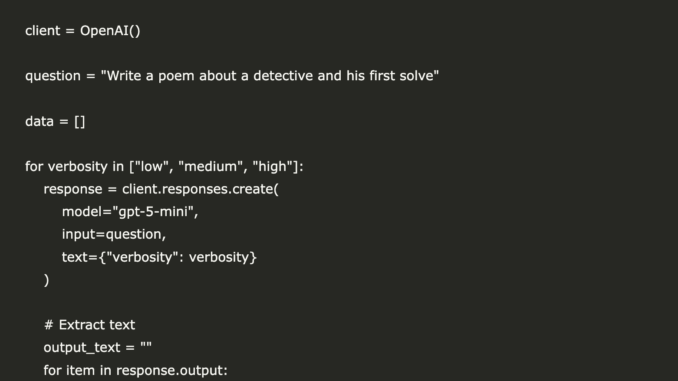
In this tutorial, we’ll explore the new capabilities introduced in OpenAI’s latest model, GPT-5. The update brings several powerful features, including the Verbosity parameter, Free-form Function Calling, Context-Free Grammar (CFG), and Minimal Reasoning. We’ll look at what they do and how to use them in practice. Check out the Full Codes here.
Installing the libraries
To get an OpenAI API key, visit https://platform.openai.com/settings/organization/api-keys and generate a new key. If you’re a new user, you may need to add billing details and make a minimum payment of $5 to activate API access. Check out the Full Codes here.
from getpass import getpass
os.environ[‘OPENAI_API_KEY’] = getpass(‘Enter OpenAI API Key: ‘)
Verbosity Parameter
The Verbosity parameter lets you control how detailed the model’s replies are without changing your prompt.
low → Short and concise, minimal extra text.
medium (default) → Balanced detail and clarity.
high → Very detailed, ideal for explanations, audits, or teaching. Check out the Full Codes here.
import pandas as pd
from IPython.display import display
client = OpenAI()
question = “Write a poem about a detective and his first solve”
data = []
for verbosity in [“low”, “medium”, “high”]:
response = client.responses.create(
model=”gpt-5-mini”,
input=question,
text={“verbosity”: verbosity}
)
# Extract text
output_text = “”
for item in response.output:
if hasattr(item, “content”):
for content in item.content:
if hasattr(content, “text”):
output_text += content.text
usage = response.usage
data.append({
“Verbosity”: verbosity,
“Sample Output”: output_text,
“Output Tokens”: usage.output_tokens
})
df = pd.DataFrame(data)
# Display nicely with centered headers
pd.set_option(‘display.max_colwidth’, None)
styled_df = df.style.set_table_styles(
[
{‘selector’: ‘th’, ‘props’: [(‘text-align’, ‘center’)]}, # Center column headers
{‘selector’: ‘td’, ‘props’: [(‘text-align’, ‘left’)]} # Left-align table cells
]
)
display(styled_df)
The output tokens scale roughly linearly with verbosity: low (731) → medium (1017) → high (1263).
Free-Form Function Calling
Free-form function calling lets GPT-5 send raw text payloads—like Python scripts, SQL queries, or shell commands—directly to your tool, without the JSON formatting used in GPT-4. Check out the Full Codes here.
This makes it easier to connect GPT-5 to external runtimes such as:
Code sandboxes (Python, C++, Java, etc.)
SQL databases (outputs raw SQL directly)
Shell environments (outputs ready-to-run Bash)
Config generators
client = OpenAI()
response = client.responses.create(
model=”gpt-5-mini”,
input=”Please use the code_exec tool to calculate the cube of the number of vowels in the word ‘pineapple'”,
text={“format”: {“type”: “text”}},
tools=[
{
“type”: “custom”,
“name”: “code_exec”,
“description”: “Executes arbitrary python code”,
}
]
)
This output shows GPT-5 generating raw Python code that counts the vowels in the word pineapple, calculates the cube of that count, and prints both values. Instead of returning a structured JSON object (like GPT-4 typically would for tool calls), GPT-5 delivers plain executable code. This makes it possible to feed the result directly into a Python runtime without extra parsing.
Context-Free Grammar (CFG)
A Context-Free Grammar (CFG) is a set of production rules that define valid strings in a language. Each rule rewrites a non-terminal symbol into terminals and/or other non-terminals, without depending on the surrounding context.
CFGs are useful when you want to strictly constrain the model’s output so it always follows the syntax of a programming language, data format, or other structured text — for example, ensuring generated SQL, JSON, or code is always syntactically correct.
For comparison, we’ll run the same script using GPT-4 and GPT-5 with an identical CFG to see how both models adhere to the grammar rules and how their outputs differ in accuracy and speed. Check out the Full Codes here.
import re
client = OpenAI()
email_regex = r”^[A-Za-z0-9._%+-]+@[A-Za-z0-9.-]+\.[A-Za-z]{2,}$”
prompt = “Give me a valid email address for John Doe. It can be a dummy email”
# No grammar constraints — model might give prose or invalid format
response = client.responses.create(
model=”gpt-4o”, # or earlier
input=prompt
)
output = response.output_text.strip()
print(“GPT Output:”, output)
print(“Valid?”, bool(re.match(email_regex, output)))
client = OpenAI()
email_regex = r”^[A-Za-z0-9._%+-]+@[A-Za-z0-9.-]+\.[A-Za-z]{2,}$”
prompt = “Give me a valid email address for John Doe. It can be a dummy email”
response = client.responses.create(
model=”gpt-5″, # grammar-constrained model
input=prompt,
text={“format”: {“type”: “text”}},
tools=[
{
“type”: “custom”,
“name”: “email_grammar”,
“description”: “Outputs a valid email address.”,
“format”: {
“type”: “grammar”,
“syntax”: “regex”,
“definition”: email_regex
}
}
],
parallel_tool_calls=False
)
print(“GPT-5 Output:”, response.output[1].input)
This example shows how GPT-5 can adhere more closely to a specified format when using a Context-Free Grammar.
With the same grammar rules, GPT-4 produced extra text around the email address (“Sure, here’s a test email you can use for John Doe: [email protected]”), which makes it invalid according to the strict format requirement.
GPT-5, however, output exactly [email protected], matching the grammar and passing validation. This demonstrates GPT-5’s improved ability to follow CFG constraints precisely. Check out the Full Codes here.
Minimal Reasoning
Minimal reasoning mode runs GPT-5 with very few or no reasoning tokens, reducing latency and delivering a faster time-to-first-token.
It’s ideal for deterministic, lightweight tasks such as:
Data extraction
Formatting
Short rewrites
Simple classification
Because the model skips most intermediate reasoning steps, responses are quick and concise. If not specified, the reasoning effort defaults to medium. Check out the Full Codes here.
from openai import OpenAI
client = OpenAI()
prompt = “Classify the given number as odd or even. Return one word only.”
start_time = time.time() # Start timer
response = client.responses.create(
model=”gpt-5″,
input=[
{ “role”: “developer”, “content”: prompt },
{ “role”: “user”, “content”: “57” }
],
reasoning={
“effort”: “minimal” # Faster time-to-first-token
},
)
latency = time.time() – start_time # End timer
# Extract model’s text output
output_text = “”
for item in response.output:
if hasattr(item, “content”):
for content in item.content:
if hasattr(content, “text”):
output_text += content.text
print(“——————————–“)
print(“Output:”, output_text)
print(f”Latency: {latency:.3f} seconds”)

I am a Civil Engineering Graduate (2022) from Jamia Millia Islamia, New Delhi, and I have a keen interest in Data Science, especially Neural Networks and their application in various areas.





Be the first to comment